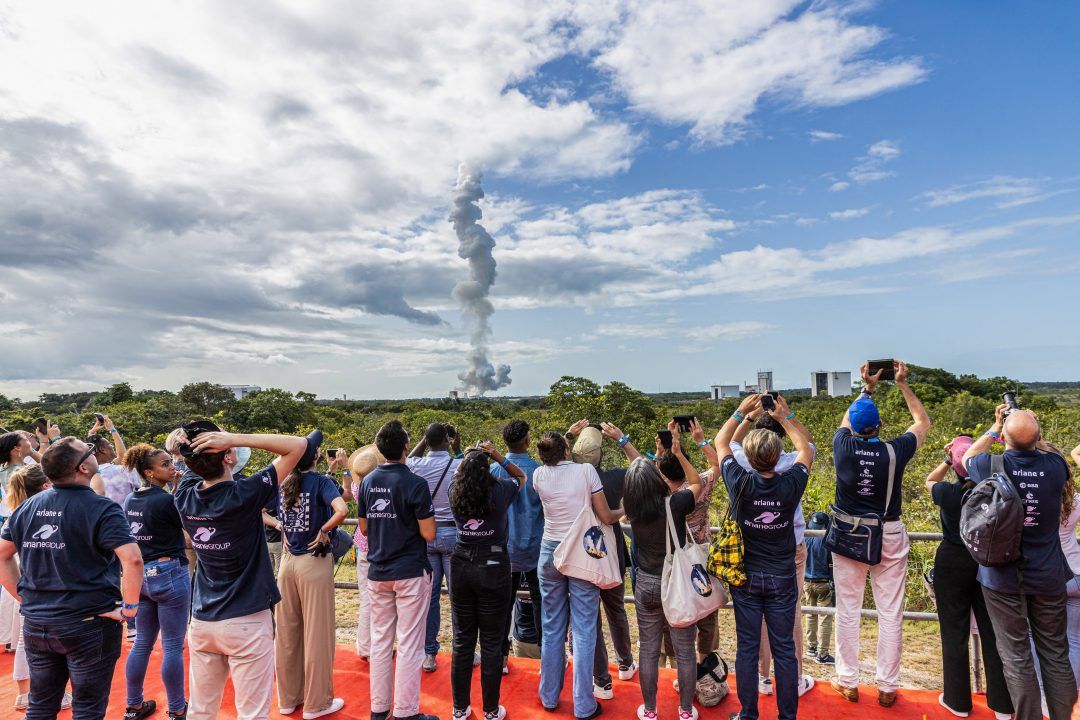
©JODY AMIETAFP
Europe's new Ariane 6 rocket successfully blasted off for the first time on Tuesday, releasing satellites into orbit and restoring the continent's independent access to space.
European space efforts have suffered a series of blows, including four years of delays to Ariane 6, that have robbed the continent of its own way to launch missions into space for the past year.
But with the successful inaugural flight of Europe's most powerful rocket yet, European space chiefs were keen to move on from recent setbacks.
Surrounded by jungle on the South American coast, the rocket launched from Europe's spaceport in Kourou, French Guiana at 4 pm local time (1900 GMT).
The mission faced a slight setback as the rocket deviated from its trajectory towards the end of the flight, failing to carry out its planned re-entry into the earth's atmosphere and landing in the Pacific.
Since the last flight of its workhorse predecessor, Ariane 5, a year ago, Europe has had to rely on rivals such as Elon Musk's US firm SpaceX.
Selected by the ESA back in 2014, Ariane 6 will able to place satellites in geostationary orbit 36,000 kilometres above Earth, as well as satellite constellations a few hundreds of kilometres up.
Historically, nearly half of the first launches of new rockets have ended in failure. That includes Ariane 5, which exploded moments after liftoff in 1996.
But out of 117 launches over nearly 20 years, only one other Ariane 5 flight completely failed.
Space has become big business and competition is soaring, particularly from SpaceX's fully re-usable Falcon 9 rockets, which now launch around twice a week.
Yet Europe has recently found itself without an independent way to give lucrative satellites a ride into space.
Russia pulled its Soyuz rockets, long used for European launches at Kourou, after Moscow invaded Ukraine in 2022.
The next challenge will be to "successfully ramp up" the number of flights, ESA space transportation director Toni Tolker-Nielsen said.
Six launches are scheduled for next year, and eight for 2026.
The rocket has an order book of 29 missions, many of which are to deploy some of Amazon's Kuiper constellation of internet satellites.
Mathieu Rabechault and Daniel Lawler, with AFP
European space efforts have suffered a series of blows, including four years of delays to Ariane 6, that have robbed the continent of its own way to launch missions into space for the past year.
But with the successful inaugural flight of Europe's most powerful rocket yet, European space chiefs were keen to move on from recent setbacks.
Surrounded by jungle on the South American coast, the rocket launched from Europe's spaceport in Kourou, French Guiana at 4 pm local time (1900 GMT).
The mission faced a slight setback as the rocket deviated from its trajectory towards the end of the flight, failing to carry out its planned re-entry into the earth's atmosphere and landing in the Pacific.
Since the last flight of its workhorse predecessor, Ariane 5, a year ago, Europe has had to rely on rivals such as Elon Musk's US firm SpaceX.
Selected by the ESA back in 2014, Ariane 6 will able to place satellites in geostationary orbit 36,000 kilometres above Earth, as well as satellite constellations a few hundreds of kilometres up.
Historically, nearly half of the first launches of new rockets have ended in failure. That includes Ariane 5, which exploded moments after liftoff in 1996.
But out of 117 launches over nearly 20 years, only one other Ariane 5 flight completely failed.
Space has become big business and competition is soaring, particularly from SpaceX's fully re-usable Falcon 9 rockets, which now launch around twice a week.
Yet Europe has recently found itself without an independent way to give lucrative satellites a ride into space.
Russia pulled its Soyuz rockets, long used for European launches at Kourou, after Moscow invaded Ukraine in 2022.
The next challenge will be to "successfully ramp up" the number of flights, ESA space transportation director Toni Tolker-Nielsen said.
Six launches are scheduled for next year, and eight for 2026.
The rocket has an order book of 29 missions, many of which are to deploy some of Amazon's Kuiper constellation of internet satellites.
Mathieu Rabechault and Daniel Lawler, with AFP
Read more




Comments